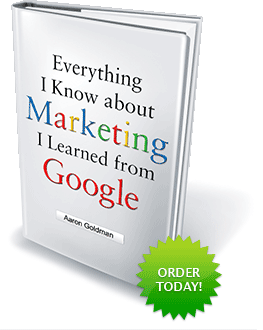Penry Price
VP, Global Agency and Industry Development
Google
1/29/10
What is your current role?
[I’m] running [Google’s] global agency business development team of roughly 200 individuals. [I’mf] focused on how Google can help agencies with technology, product development, resourcing and training, etc.
Currently Google only gets about 1% of the ad spend from the major holding companies. There’s a disconnect between where consumers spend their time and where advertisers (and their agencies) spend their budgets. [My job is to close that gap.]
What is Google doing to attract brand advertising dollars?
In the early days of the web, the basic value proposition of the Internet for marketers was a direct relationship vis-a-vis the click. The click told marketers what consumers think about your product. This pushed the Web to the bottom of the marketing funnel as opposed to the top where emotional connections are made.
Back then, banners, buttons and pop-ups were the only ads online with visuals and they were all crappy, intrusive and not relevant. Ads were bought and sold as eyeballs, not people. There was no concept for brands to find this attractive.
Yahoo and Wenda Millard are credited with opening the eyes of brand advertisers to the potential of the web. They packaged content appropriately for consumers and sold it like magazines — eg, readers and audience, not eyeballs and clicks. This allowed the media community to understand who these users were
To this day, the industry still struggles to get brand dollars because of its emphasis on the click. Rich Silverstein [once] remarked [at a meeting I attended], “Until I cry from an ad I see on the web, it’ll always be a direct response channel.”
Video and YouTube are a huge opportunity to attract brand dollars because it has the emotional appeal while still being targeted and measurable. Google’s display business is growing phenomenally.
Branding is going away because there are now metrics attached to every piece of commercial messaging, not just taglines. Every call-to-action is tracked. For Nike, it’s not only about “Just Do It” — it’s about driving to websites, stores, etc.
Advertising is meant to help sell product. That’s what Google AdWords does. Google is having success positioning it ads as a sales channel, not a marketing expense. Budgets are coming from CFO’s not CMO’s.
Text ads can drive brand association and connection. 3rd party research supports this. If companies are using the web the right way, their websites should be their most compelling piece of branding. Google delivers billions of people to websites each month where brand experiences are delivered. Websites are much better than 30 second spots or print ads for branding. Therefore Google is a very effective branding channel.
Is Google an advertising company?
I always chuckle at this question. Yes, to a degree in that people buy ads from Google but that doesn’t tell the whole story. The terminology is changing. Advertising as we know it is changing. Anyone anywhere in the world that has something to say, sell or buy can use Google AdWords.
Do you ever see a day when advertising is not Google’s main source of revenue?
Not right now. [Although, I’m] highly intrigued by [Google’s] enterprise efforts.
Mobile advertising area is very interesting and it may get bucketed as ad revenue but it’s really mobile computing, not advertising, where the opportunity is.
What are the biggest hurdles you have to penetrating ad agencies? What keeps you up at night?
Google is still very difficult to buy from. [There are] new tools every day.
The agency workflow process for online advertising is still very inefficient. [At Google, we] have to get in the mindset of the media planner. We need to eliminate anything that gets in their way or is a pain in the ass. Google needs to help make their jobs easier and make them look good to their bosses. The entire process from brief to planning to buying to trafficking to reporting to billing to reconciliation is fraught with inefficiency. AdPlanner, MediaVisor and other DoubleClick tools seek to empower agencies
Will Google ever get back into radio and print?
Who knows what the future holds. The feedback loop is very hard.
Google saw its print and radio experiments as successes. We got so much info about what was good and bad, what worked and what didn’t work. We learned a lot about the importance of the feedback loop to advertising.






